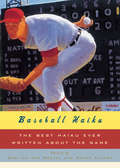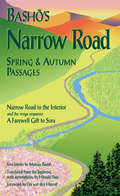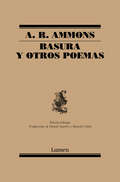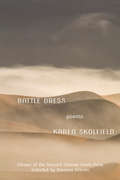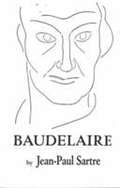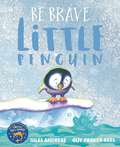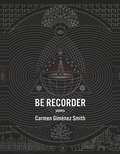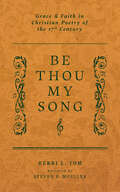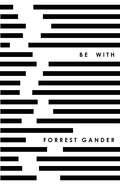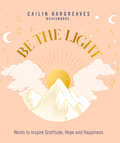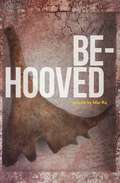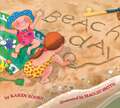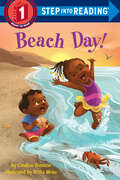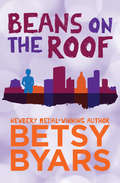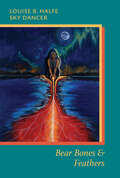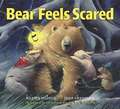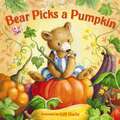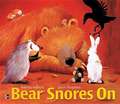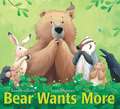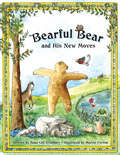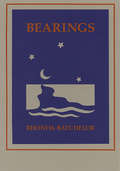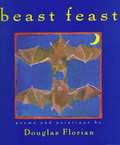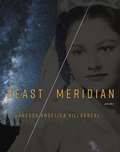- Table View
- List View
Baseball Haiku: The Best Haiku Ever Written about the Game
by Nanae Tamura Cor van den HeuvelPresenting more than two hundred of the greatest haiku ever written about the game. One of the most unusual baseball books of the 2007 season, this remarkable new collection, which includes poems from both America and Japan, captures perfectly the thrill of baseball--a double play, a game of catch, or the hushed pause as a pitcher looks in before hurling his pitch. Like haiku, the game is concerned with the nature of the seasons: joyous in the spring, thrilling in summer's heat, ripening with the descent of fall, and remembered fondly in winter. Featuring the work of Jack Kerouac, the king of the Beat writers, who penned the first American baseball haiku, and Alan Pizzarelli, a major American haiku poet, the collection also includes Masaoka Shiki, one of the four great pillars of Japanese haiku, who fell in love with baseball when he was a student in Tokyo. Baseball Haiku, a literary and baseball treasure, will make a marvelous gift for the baseball fan in your family.
Baseball, Snakes, and Summer Squash: Poems About Growing Up
by Donald Graves Paul BirlingThis unsentimental and ambitious collection of poems by Donald Graves chronicles the American childhood of a boy as he moves with his family to a house in the country, and the changes the boy experiences in that year. From formidable lessons learned from a bully, and facing parents after breaking curfew with his brother, to math woes and misadventures with his independent Scottish terrier, Rags, the poet's convincing voice gives the reader a generous, spirited perspective of growing up. Black-and-white illustrations add an appealing visual element to this coming-of-age collection.
Basho's Narrow Road
by Matsuo Basho Hiroaki SatoMatsuo Basho (1644-94) is considered Japan's greatest haiku poet. Narrow Road to the Interior (Oku no Hosomichi) is his masterpiece. Ostensibly a chronological account of the poet's five-month journey in 1689 into the deep country north and west of the old capital, Edo, the work is in fact artful and carefully sculpted, rich in literary and Zen allusion and filled with great insights and vital rhythms. In Basho's Narrow Road: Spring and Autumn Passages, poet and translator Hiroaki Sato presents the complete work in English and examines the threads of history, geography, philosophy, and literature that are woven into Basho's exposition. He details in particular the extent to which Basho relied on the community of writers with whom he traveled and joined in linked verse (renga) poetry sessions, an example of which, A Farewell Gift to Sora, is included in this volume. In explaining how and why Basho made the literary choices he did, Sato shows how the poet was able to transform his passing observations into words that resonate across time and culture.
Basura y otros poemas
by A.R. AmmonsLa obra de uno de los mayores poetas estadounidenses del siglo XX traducida por primera vez en España. En este volumen reunimos, por una parte, Basura, un portentoso poema largo, una verdadera épica de las ideas y acerca de la relación del hombre con la materia, y, por otro, una selección de sus mejores poemas breves, de tal modo que la magnitud y la ambición del poeta quedan justamente representadas. Las traducciones de Daniel Aguirre y de Marcelo Cohen, así como los textos que las acompañan, suponen la cabal presentación en el ámbito hispánico de un poeta esencial de nuestro tiempo. A.R. Ammons es uno de los grandes poetas norteamericanos del siglo XX. Junto a John Ashbery, es sin duda uno de los pocos que supieron seguir con valentía el camino abierto por Wallace Stevens, su antecesor más cercano. Reseña:«Ammons se presenta como el poeta del intransigente control geométrico de la Tierra sobre los hombres. Tuvo que aprender a ser distinto de lo que era y regresar de nuevo a los orígenes, con una exigencia musical siempre mayor. El canon de la poesía estadounidense lo insertará en la tradición quizá más profundamente de lo que él pretendía.» Harold Bloom
Battle Dress: Poems
by Karen Skolfield“A terrific and sometimes terrifying collection—morally complex, rhythmic, tough-minded, and original.” —Rosanna Warren, 2018 Barnard Women Poets Prize citation In a poetic voice at once accessible and otherworldly, gutsy and insightful, U.S. Army veteran Karen Skolfield offers a rare glimpse of a female soldier’s training and mental conditioning. Through the narratives of a young soldier, her older counterpart, and her fellow soldiers, Skolfield searches for meaning in combat preparation, long-term trauma, and the way war is embedded in our language and psyche.
Baudelaire
by Jean-Paul Sartre Martin TurnellThe abstractions like Existence and Being, Freedom and Nature are turned into a theory of psychoanalysis, stuck in man's creativity and opposed to Freudian determinism. This theory is put into practice in this book on Baudelaire.
Be Brave Little Penguin
by Giles AndreaeA feel-good rhyming story with a positive message about confidence and self-esteem, from the creators of international bestseller, Giraffes Can't Dance.Little Penguin Pip-Pip would love to join in with all his friends swimming in the sea, but there's just one problem . . . he's scared of water. Can Pip-Pip overcome his fears and finally take the plunge? This irresistible story shows that sometimes all it takes is a little bit of encouragement - and a whole lot of heart - to finally make that leap!This touching tale will soon become a new family favourite.Praise for Giraffes Can't Dance:'All toddlers should grow up reading this or hearing their parents read it aloud to them' - Daily Telegraph'A rhyming story with superb illustrations' - Independent'This delightful picture book is written in lively rhyming text with vivacious illustrations' - Junior
Be Recorder: Poems
by Carmen GiménezFinalist for the National Book Award for Poetry • Finalist for the PEN Open Book Award • Finalist for the Los Angeles Times Book PrizeCarmen Giménez Smith dares to demand renewal for a world made unrecognizableBe Recorder offers readers a blazing way forward into an as yet unmade world. The many times and tongues in these poems investigate the precariousness of personhood in lines that excoriate and sanctify. Carmen Giménez Smith turns the increasingly pressing urge to cry out into a dream of rebellion—against compromise, against inertia, against self-delusion, and against the ways the media dream up our complacency in an America that depends on it. This reckoning with self and nation demonstrates that who and where we are is as conditional as the fact of our compliance: “Miss America from sea to shining sea / the huddled masses have a question / there is one of you and all of us.” Be Recorder is unrepentant and unstoppable, and affirms Giménez Smith as one of the most vital and vivacious poets of our time.
Be Thou My Song: Grace and Faith in Christian Poetry in the Seventeenth Century
by Kerri L Tom"Be Thou my Song" is a line from seventeenth-century poet Edward Taylor. In his meditation on Philippians 2:9, Taylor finds that his ability to compose poetry falls short of his desire to glorify God, so he prays, “ That I thy glorious Praise may Trumpet right, / Be thou my Song, and make Lord, mee thy Pipe.” In one way or another, all of the poets included in the chapters of Be Thou My Song strive to convey their wonder for God' s unending grace and mercy in their own limited ways; He provides the content, the song, while the writers are merely the conduits, the pipe. By reading these poems carefully, we can share in their gratitude for how God cares for us, both here on earth and in our final heavenly home.In each chapter, you will find a poem, presented in its entirety, followed by an exploration of that poem and some questions to contemplate afterwards. The goal of these explorations is to provide readers with a deeper appreciation, a deeper understanding, and a deeper love of what each poet has given to us.
Be With
by Forrest GanderForrest Gander’s first book of poems since his Pulitzer finalist Core Samples from the World: a startling look through loss, grief, and regret into the exquisite nature of intimacy <P><P> Drawing from his experience as a translator, Forrest Gander includes in the first, powerfully elegiac section a version of a poem by the Spanish mystical poet St. John of the Cross. He continues with a long multilingual poem examining the syncretic geological and cultural history of the U.S. border with Mexico. <P><P>The poems of the third section—a moving transcription of Gander’s efforts to address his mother dying of Alzheimer’s—rise from the page like hymns, transforming slowly from reverence to revelation. Gander has been called one of our most formally restless poets, and these new poems express a characteristically tensile energy and, as one critic noted, “the most eclectic diction since Hart Crane.”
Be the Light: Words to Inspire Gratitude, Hope and Happiness
by Cailin HargreavesIf you do not release yourself from what has gone how will you hold onto what is coming?Let go of the things that let you go.An inspirational contemporary collection of words, prose and illustrations providing short, thought-provoking daily prompts for positivity, hope, happiness, and encouragement. Be the Light honours the beauty of our scars and celebrates the strength that lives inside us all.Broken into six themes: Believe in Your Power, Let Yourself Be Seen, You Deserve Happiness, Healing Old Wounds, You Are Enough and Never Underestimate Your Strength, each chapter starts with a short commentary on the theme and is followed by reflective words to encourage the reader to examine their own personal story.Each chapter features short prose and poems alongside Cay's uplifting illustrations.
Be the Light: Words to Inspire Gratitude, Hope and Happiness
by Cailin HargreavesIf you do not release yourself from what has gone how will you hold onto what is coming?Let go of the things that let you go.An inspirational contemporary collection of words, prose and illustrations providing short, thought-provoking daily prompts for positivity, hope, happiness, and encouragement. Be the Light honours the beauty of our scars and celebrates the strength that lives inside us all.Broken into six themes: Believe in Your Power, Let Yourself Be Seen, You Deserve Happiness, Healing Old Wounds, You Are Enough and Never Underestimate Your Strength, each chapter starts with a short commentary on the theme and is followed by reflective words to encourage the reader to examine their own personal story.Each chapter features short prose and poems alongside Cay's uplifting illustrations.
Be-Hooved (The Alaska Literary Series)
by Mar KaMar Ka lives in and writes from the foothills of Alaska’s Chugach Mountains. Be-Hooved, her new poetry collection, creates a layered spiritual memoir of her decades in the northern wilderness. The poems inhabit her surroundings—structured along the seasons and the migration patterns of the Porcupine Caribou Herd—and are wrought with a fine and luminous language. Entrancing, profound, and startling, this book is a testament to hope before change, persistence before confusion, and empathy before difference: all the world’s light and all the world’s dark / can fit into an eye into a heart.
Beach Day
by Karen RoosaIn this charming picture book, a cheerful family tumbles out of the car and onto the beach, ready for a perfect day. Buoyant verse just right for reading aloud and bright, playful illustrations capture the singular feeling of a hazy, lazy day by the ocean, complete with a ball game with new friends, water-skiers and sailboats, and a picnic lunch of fried chicken and deviled eggs. This book is a captivating introduction to the beach for young children and an irresistible gift for beach lovers of any age.
Beach Day! (Step into Reading)
by Candice RansomSummer sun and fun in this Step 1 reader featuring the family from Pumpkin Day!, Apple Picking Day!, Garden Day, and Snow Day!Family time means it's time to pack up the car and head to the beach! The brother and sister from Pumpkin Day! and its many companion books return for a fabulous day at the shore. Collecting seashells, building a sand castle, visiting the seaside attractions--enjoy all the indelible memories of childhood summers! Easy-to-follow rhyme ensures a successful reading experience, while bright, lively art brings the story to life.Step 1 Readers feature big type and easy words. Rhymes and rhythmic text paired with picture clues help children decode the story. For children who know the alphabet and are eager to begin reading.
Beans on the Roof
by Betsy ByarsAnna Bean goes to the roof in search of inspiration, and soon her family will follow her into a new world just a few floors above their homeThe Bean children are not allowed to play on the roof of their apartment building. One evening Anna Bean goes up to the roof—not to play, but to be alone so she can write a poem for school. Her poetry writing fever is contagious; one by one, the rest of the Bean family visits the roof to write amongst pigeons and tall buildings—all except George, who can&’t think of anything to write about. Beans on the Roof is a wonderful, inspiring story for young readers with a passion for creative writing. This ebook features an illustrated biography of Betsy Byars including rare images from the author&’s personal collection.Images from previously published versions of this content have been removed to avoid copyright infringement.
Bear Bones & Feathers
by Louise B. HalfeIn this new edition of her powerful debut, Plains Cree writer and National Poet Laureate Louise B. Halfe – Sky Dancer reckons with personal history within cultural genocide. Employing Indigenous spirituality, black comedy, and the memories of her own childhood as healing arts, celebrated poet Louise B. Halfe – Sky Dancer finds an irrepressible source of strength and dignity in her people. Bear Bones and Feathers offers moving portraits of Halfe’s grandmother (a medicine woman whose life straddled old and new worlds), her parents (both trapped in a cycle of jealousy and abuse), and the people whose pain she witnessed on the reserve and at residential school. Originally published by Coteau Books in 1994, Bear Bones and Feathers won the Milton Acorn People's Poet Award, and was a finalist for the Spirit of Saskatchewan Award, the Pat Lowther Award, and the Gerald Lampert Award.
Bear Feels Scared
by Karma Wilson Jane ChapmanBear is big, but the forest is bigger. A storm is brewing and he can't find his way home. The star of "Bear Feels Sick" and "Bear Snores On" returns in this delightful story about friendship and loyalty.
Bear Picks a Pumpkin
by ZondervanSnuggle up in the cool fall weather with a cozy blanket, a pumpkin spice latte, and your little one as you follow the whimsical, rhyming quest of Bear on his way to find the perfect pumpkin.Will he choose a tall one? A tiny one? One with stripes? Or perhaps a pumpkin white as snow?Read along and find out which pumpkin Bear (and his friends) will choose!Here&’s a silly pumpkin! It&’s bumpy and unique. But there are still more pumpkins, So let&’s go and take a peek. Here&’s another pumpkin, Bear! It&’s perfect, don&’t you say? It&’s round and smooth and not too big— Just right for you! Hooray!Bear Picks a Pumpkin:Is perfect for little readersBlends the warmth and joy of autumn with a powerful message of friendshipIs written in soothing, rhyming text, fun to read for parents and kids alike
Bear Snores On (Elementary Core Reading Ser.)
by Karma Wilson Jane ChapmanNIMAC-sourced textbook <P><P>On a cold winter night many animals gather to party in the cave of a sleeping bear, who then awakes and protests that he has missed the food and the fun.
Bear Wants More
by Karma WilsonWhen springtime comes, in his warm winter den a bear wakes up very hungry and thin!. . . Bear finds some roots to eat, but that's not enough. He wants more! With his friends' help, he finds some berries, clover, and fish to eat, but that's not enough. Bear wants more! How Bear's friends help him to finally satisfy his HUGE hunger in a most surprising way will enchant young readers. Karma Wilson's rhythmic text and Jane Chapman's vibrant illustrations make Bear Wants More a perfect springtime read-aloud. Other books about Bear are available from Bookshare.
Bearful Bear and His New Moves
by Anna Lee EverhartWhile Bearful Bear goes about another day in the forest, he wonders whether he can learn to move like all of the animals around him. Every creature he encounters shares how they move, and then Bearful has the opportunity to practice his new skill. Children will learn how to fly, gallop, hop, and more with this rhythmic, rhyming tale about an inquisitive bear whose animal friends teach him to move in many new ways. These catchy how-to's not only encourage movement by the reader, but also encourage language development and outright fun!
Bearings
by Rhonda BatchelorThe poems in Bearings are arranged in the stressful rhythm of alternation between the intense states of being in love and/or with someone or being alone. Loss refines the vision. For Rhonda Batchelor's poetry that means a gain which shows, for example, in occasional tender lyrics about experiences not governed by love and in the tang of the west coast in her poems, though setting is never the central thing. The centre is love, particularized with an art that revitalizes the ancient subject.
Beast Feast
by Douglas FlorianIn this hilarious collection of twenty-one original animal poems and paintings, the animals are out in all their finned, furry, and feathered glory. From lobsters to rheas to fireflies, kiwis to camels to chameleons, there’s a beast for everyone to love!
Beast Meridian
by Vanessa VillarrealBEAST MERIDIAN narrates the first- generation Mexican American girl, tracking the experiences of cultural displacement, the inheritance of generational trauma, sexist and racist violence, sexual assault, economic struggle, and institutional racism and sexism that disproportionately punishes brown girls in crisis. <p><p> Narrated by a speaker in mourning marked as an at- risk juvenile, psychologically troubled, an offender, expelled and sent to alternative school for adolescents with behavioral issues, and eventually, a psychiatric hospital, it survives the school to prison pipeline, the immigrant working class condition, grueling low- pay service jobs, conservative classism against Latinxs in Texas, queerness, assimilation, and life wrapped up in frivolous citations, fines, and penalties. The traumatic catalyst for the long line of trouble begins with the death of a beloved young grandmother from preventable cervical cancer—another violence of systemic racism and sexism that prevents regular reproductive and sexual health care to poor immigrant communities—and the subsequent deaths of other immigrant family members who are mourned in the dissociative states amidst the depressive trauma that opens the book. <p> The dissociative states that mark the middle—a surreal kind of shadowland where the narrator encounters her animal self and ancestors imagined as animals faces brutal surreal challenges on the way back to life beyond trauma—is a kind of mictlan, reimagined as a state of constant mourning that challenges American notions of "healing" from trauma, and rather acknowledges sadness, mourning, and memory as a necessary state of constant awareness to forge a "way back" toward a broader healing of earth, time, body, history.
